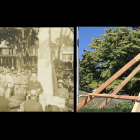
A. L. Benedict first proposed what would become the Wayside Cross in a letter to the editor of the Advertiser in 1915 He proposed that the 18 acres donated to the town be made into the Soldiers’ and Sailors’ Memorial Park. His idea was rejected, and the land later became Mead Memorial Park. However, the Town recognized the need for some sort of war memorial, and residents proceeded to fight over the specifics for the next eight years. By 1919, it seems that sufficient funds had been raised, but there was no clear direction to the project. The idea for the memorial to take the shape of a cross and to be at the base of God’s Acre seems to have come from local artist Daniel Putnam Brinley, a prominent member of the Silvermine Guild of Artists. The cross itself was designed by both Francis Adams Kent and W. Frank Purdy, who was the director of the American School of Sculpture and a local resident. Francis Adams Kent was a student of Gutzman Borglum, the artist who carved Mount Rushmore, and the brother of Solon Borglum, who started the artist colony in Silvermine in 1908. The Wayside Cross was dedicated at 3 pm September 9, 1923. 1,500 people attended to honor the fallen soldiers from New Canaan. Major General John F. O’Ryan and Admiral Robert P. Forshew were both invited to address the crowd. Lieutenant Commander F. L. Humpreys, pictured above, read “the Roll of Honor of New Canaan who made the Great Sacrifice.” The ceremony was recorded in meticulous detail by the Advertiser and featured seven photographs, which was very unusual for the time, as well as a transcription of the opening remarks and the general’s. Even fifteen years later, the ceremony was described as one of the greatest things to happen here in New Canaan. The Celtic cross is carved from travertine limestone imported from Rome. The cross alone weighs 10 tons and stands sixteen feet five inches tall. There are five carved panels on the front of the cross representing the Revolution, the War of 1812, the Civil War, the Spanish American War, and finally World War I. Columbia, the personification of the United States, is depicted in each of the panels – freeing an enslaved person, holding a ship, and rushing off to Europe armed with a sword and shield. The pedestal on which it sits is inscribed with “Dedicated to the glory of Almighty God in memory of the New Canaan men and women who, by their unselfish patriotism, have advanced the American ideals of liberty and the brotherhood of man.” The other three sides are inscribed with “service,” “sacrifice,” and “loyalty.” These inscriptions were finished three weeks after the cross was installed so that they could be adjusted for the natural light.

